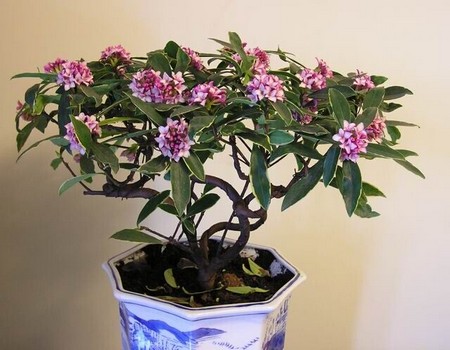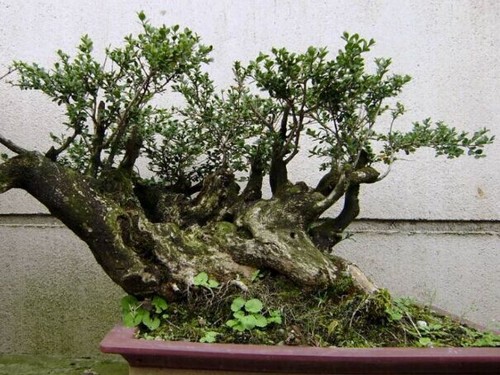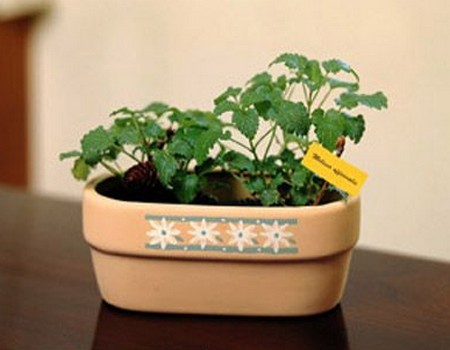Production method of Daphne odora bonsai in Phnom Penh
Daphne has whirling branches, soft strips and thick leaves and elegant posture. Phnom Penh Daphne belongs to the evergreen shrub of Daphne odora. It is a variety of Daphne. No matter when it is, the planting of plants is a kind of technical work for examiners, which requires not only knowledge, but also enough patience and care. Then let's take a look at the production method of Phnom Penh Ruixiang bonsai with the editor.

The fragrance of Phnom Penh Daphne is strong, like semi-overcast or sunny ground, avoid scorching sun exposure and rainstorm. Phnom Penh Daphne has poor cold resistance and is not resistant to waterlogging, so it is suitable to grow in fertile, loose and slightly acidic soil with good drainage, so it adopts a relatively extensive management mode in normal management.
1. Basin soil
The pots used in bonsai Phnom Penh should be of moderate size and are planted shallowly in loose and sour soil with humus. The ratio of basin to soil is 4 ∶ 4 ∶ 2 for garden soil ∶ rotten leaf soil ∶ sand. After the potted soil used in the bonsai is prepared, it is sterilized in the sun.
2. Reproduction
In spring, take 8 cm to 10 cm from the top of the branches, leave 2 to 3 leaves at the top, dip them in rooting powder, insert them in the cutting medium, insert the cuttings with the depth of 1 inch 2 to 2 cm 3, pour water thoroughly, and keep the cutting substrate moist and dry, rooting in about 20 days.
In summer, the cuttings were cut in the same year, and the insertion depth was about 1x2 of the cutting. after the cuttings were watered, the cuttings were kept moist and dry, but the leaves should be sprinkled frequently until they took root. In addition, it can also be grafted and propagated under high pressure in spring, summer and autumn.
3 upper basin
Selection basin: Ruixiang should use a deeper round basin or square basin, or duck egg round or rectangular basin. The texture of the basin is better with purple sand pottery basin. The potted color can be sunflower yellow or light gray to set off the green leaf skin roller flower and sprout to render the effect of foil.
Using soil: Ruixiang is born in a fertile and loose sandy soil with satisfactory drainage, and requires a slightly acidic soil with a pH value between 6 and 6.5. The bonsai should be mixed with rotten leaf soil or sun-dried and weathered Grange soil with appropriate amount of rice chaff ash or sand.
Planting: it should be planted in the pot in April in spring. At this time, climatology is soft, moist and moist, and the temperature difference between day and night is small, which is helpful for the growth of Ruixiang. It is also possible to plant in autumn. When transplanting, you should take more soil and prune the branches appropriately.
4. Watering
Phnom Penh Daphne leaves contain a lot of wax, so Phnom Penh Daphne leaves transpiration is very small, so it is not resistant to moisture, usually watering should be dry and wet. At the beginning of spring, the buds were watered once when they were about to sprout, and then poured thoroughly after the basin soil was dry.
In summer, in addition to keeping the basin soil dry and wet alternately, it is also necessary to spray water around it and leaves regularly to cool down. The late autumn makes the basin soil in a semi-dry state, which slows down the growth potential, which is conducive to overwintering. When the growth stagnates in winter, the basin soil should be dry and watering should be less.
5. Fertilization
Phnom Penh Ruixiang does not like big fat, under normal circumstances, usually once a month to apply mature thin fertilizer liquid. The application of thin fertilizer solution before and after flowering can make the plant luxuriant and the flower fragrant and colorful.
Fertilizer precautions: ① do not splash the fertilizer on the leaves. ② fertilization should be carried out when the basin soil is dry. ③ does not apply human faeces, urine and chemical fertilizers.
6. Pruning
Pruning Phnom Penh Daphne has strong germination and resistance to pruning. After flowering, it can be pruned according to the desired plant shape, mainly removing weak branches, over-dense branches and so on.
7. Posture
Processing: Ruixiang pot planting should use wire climbing, joint pruning to carry out modeling. However, attention should be paid to removing the wire as soon as possible, so as not to cause wire trapping and affect the appearance and growth of the wire. The processing and modeling should be in the dormant period or after flowering.
Tree shape: Daphne potted tree shape should be made into a natural tree shape, branches should be Tingxiu stretch, and pay attention to density and appropriate, in order to show flowers, rich color and fragrance, increase the ornamental effect.
8. Change the basin
Phnom Penh Daphne usually changes the basin soil once every 2 years, and changes the basin when the bud is not sprouting in early spring. After removing the pot, remove the outer soil of the root, pay attention to the soil, add newly cultivated soil to plant, the planting depth is the same as the original depth, if the plant of Phnom Penh Daphne is larger, you should change the big pot. After planting, the basin soil is compacted, watered thoroughly, and maintained in a cool and ventilated place for 10 to 15 days, normal maintenance management can be carried out.
Time: 2019-05-26 Click:
- Prev

The method of making bonsai of honeysuckle wood
Honeysuckle, or honeysuckle, is one of the most common tree species in landscaping. Flowers are excellent sources of honey, fruit is the delicacy of birds, and the whole plant can be used medicinally. Stem bark can be used to make rayon, seed oil can be used to make soap and garden greening tree species. Honeysuckle has luxuriant branches, dark green leaves and bright red fruit, which has a good ornamental effect.
- Next

The method of making bonsai in the top ten merits of broad leaves
There are many varieties of the ten broad leaves, the common ones are the dense thorns of the broad leaves, the thorns at the edge of the leaves, the thorns of the leaves without thorns, and so on, which are often used to make bonsai. Ten meritorious services stem clump, branches and leaves sparse, leaf shape changeable, evergreen all the year round. Especially when the old leaves change color to orange and red, and the new green leaves
Related
- Fuxing push coffee new agricultural production and marketing class: lack of small-scale processing plants
- Jujube rice field leisure farm deep ploughing Yilan for five years to create a space for organic food and play
- Nongyu Farm-A trial of organic papaya for brave women with advanced technology
- Four points for attention in the prevention and control of diseases and insect pests of edible fungi
- How to add nutrient solution to Edible Fungi
- Is there any good way to control edible fungus mites?
- Open Inoculation Technology of Edible Fungi
- Is there any clever way to use fertilizer for edible fungus in winter?
- What agents are used to kill the pathogens of edible fungi in the mushroom shed?
- Rapid drying of Edible Fungi

